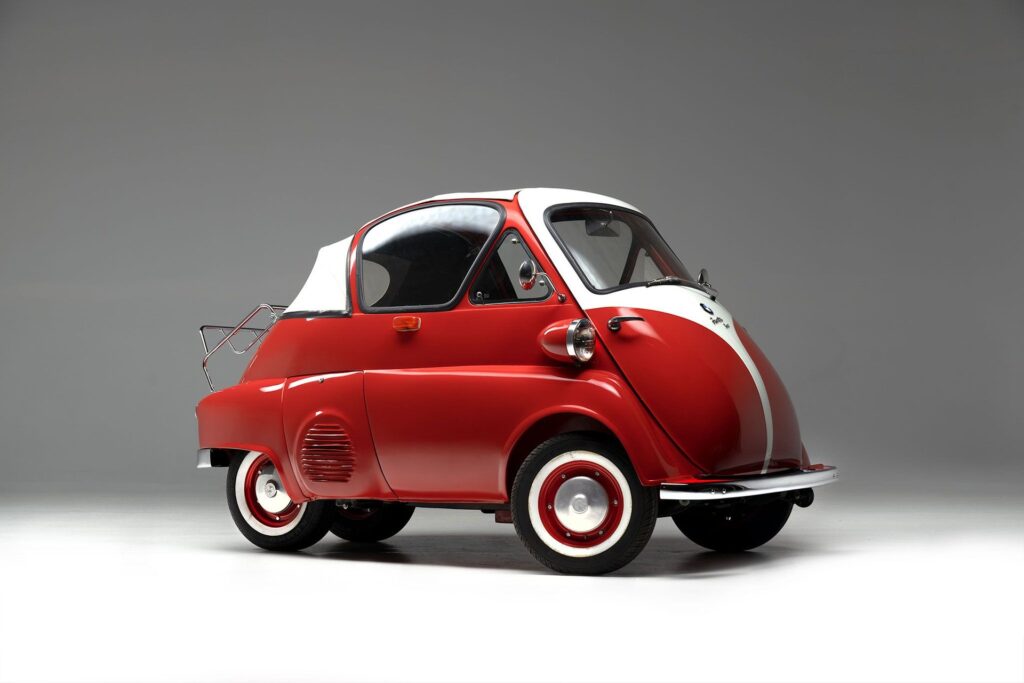
The 1956 BMW Isetta continued the success of the previous year’s model, offering an affordable and economical vehicle in a time when Europe was still feeling the effects of the Second World War. Here’s a closer look at the history and specifications of the 1956 model.
History:
The Isetta, a tiny car with an egg-like shape, was first produced by the Italian firm Iso SpA, known for manufacturing refrigerators. BMW acquired the license to produce the Isetta and began manufacturing it in 1955. The Isetta’s popularity stemmed from its affordability and excellent fuel economy, critical factors in the post-war economy.
By 1956, the Isetta was well-established in the market and was already making a significant contribution to BMW’s recovery from near bankruptcy. It was a symbol of the post-war “economic miracle” in Germany and played a crucial role in motorizing the masses.
Specifications:
The 1956 BMW Isetta largely carried over the specifications of the 1955 model. Here are the key specifications:
Engine: BMW replaced the Iso model’s two-stroke engine with its own single-cylinder, four-stroke, 247cc motorcycle engine. It had a power output of 12 horsepower at 5800 rpm.
Performance: The 1956 BMW Isetta could reach a top speed of approximately 85 km/h (53 mph). Despite its modest power, it offered impressive fuel efficiency, with a consumption of approximately 3 liters per 100 kilometers (around 78 mpg).
Body & Chassis: The Isetta retained its unusual yet charming design, featuring a door at the front of the car. This model was a two-seater, with a sunroof that could be used as an emergency exit. Its compact size made it perfect for city driving, measuring just 2.29 meters long and 1.37 meters wide.
Suspension & Brakes: The Isetta featured an independent front suspension with a leading arm and coil springs, while the rear had a semi-elliptical leaf spring. It had drum brakes on all four wheels, which were sufficient given the vehicle’s size and performance.
BMW’s decision to replace the original two-stroke engine with its own four-stroke, 247 cc engine from the R25/3 motorcycle, provided the car with an enhanced level of reliability and performance. The engine was located at the rear of the vehicle and was air-cooled, a common feature of motorcycles. Despite its modest horsepower, the Isetta could comfortably cruise at speeds of around 50 mph, more than enough for the urban commuting and short trips it was designed for.
Inside, the Isetta was surprisingly spacious for a microcar, with a bench seat that could accommodate two adults. The cabin was simple but functional, with a single instrument cluster located in the middle of the steering wheel providing the driver with essential information. Although it was far from luxurious, the Isetta was designed to be economical and efficient, fitting perfectly into the austere post-war environment.
BMW’s 1956 Isetta also retained the novel feature of an opening windshield, designed as an escape hatch in the event the front door could not be opened after a front-end collision. The sunroof also functioned as an emergency exit, further enhancing the car’s safety.
Another innovation the Isetta introduced in this era was the use of a single-cylinder engine. This was a departure from the multi-cylinder engines that were the norm in cars at the time, and it was a choice driven by the need for efficiency and cost-effectiveness.
By 1956, the Isetta had become a staple on European roads, and its success story played a crucial role in the recovery of BMW. The Isetta was the perfect car for a recovering post-war Europe – cheap, cheerful, easy to maintain, and economical to run. Despite the evolution of automobile design and technology, the Isetta remains a symbol of the innovative spirit and resilience of the automotive industry during a challenging period in history.
The 1956 BMW Isetta, much like the 1955 model, is remembered as a car that provided affordable mobility in a time of economic recovery. Its legacy as an icon of post-war European car design endures to this day.
